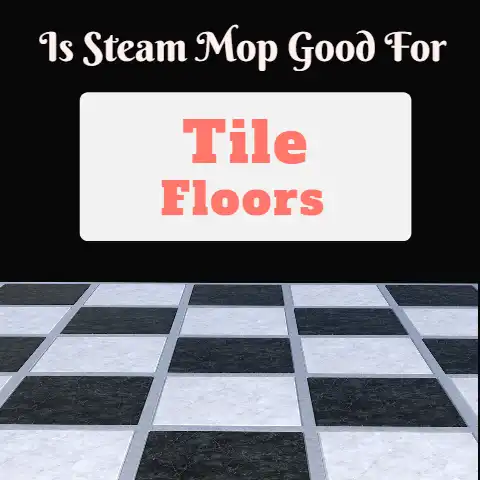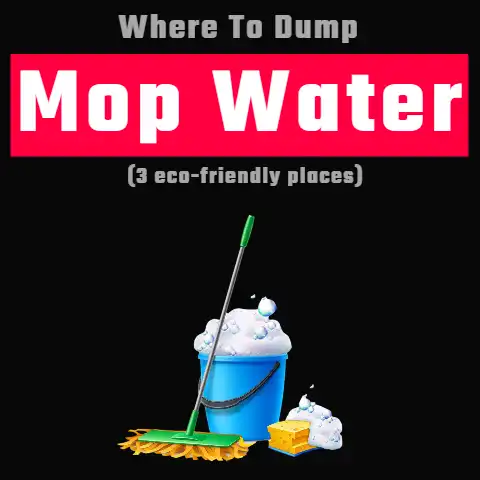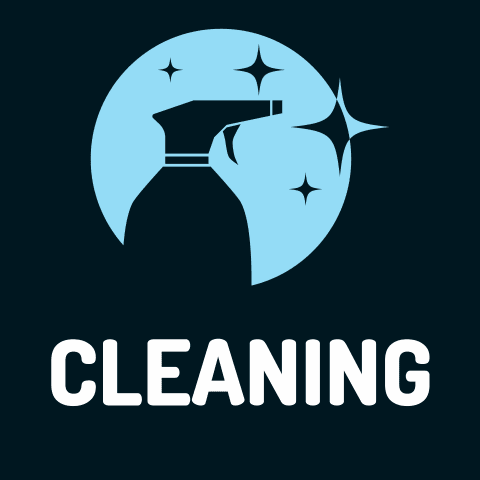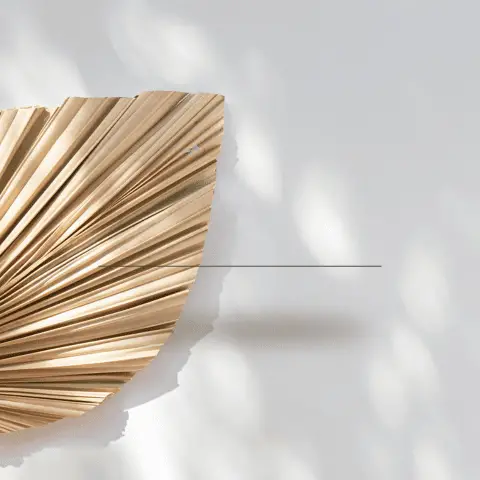3 Methods To Clean Floor Without Mop (100% Effective)
To clean a sticky floor without a mop, you can manually scrub with your hands using a cloth, use a steam mop, apply a vinegar solution or a floor cleaner, sweep with a broom and then wipe with a damp cloth, use hot water and elbow grease, or hand clean with a sponge and soapy water. Always remember to rinse the floor with clean water to avoid leaving any sticky residue.
Mops are amazingly convenient when it comes to cleaning floors. They are easy to use, easy to wash, and generally efficient.
But what happens if you don’t have a mop?
Worry not, there are several other things you can try.
In this article, we will explore alternative methods for cleaning sticky floors without the use of a mop.
By utilizing non-toxic and eco-friendly cleaning solutions, as well as homemade remedies, you can effectively remove stubborn stains and restore the shine to your floors.
We will also discuss preventative measures to help keep your floors clean and sticky-free in the future.
Key Takeaways
- There are various cleaning solutions that can be used to clean a sticky floor, including a microfiber cloth soaked in a cleaning solution, a mix of dish soap and warm water in a bucket, a vinegar and water solution, and a baking soda and water paste.
- When cleaning a sticky floor, it is important to gently scrub sticky areas using circular motions and to regularly rinse the cloth in clean water. For stubborn stains, vinegar or baking soda can be added to the cleaning process.
- Specific stains and residues such as grease or oil stains, adhesive residue, and gum or candy stuck to the floor require specific stain removal processes like hardening gum or candy with ice and then scraping it off, and using a mixture of warm water and mild detergent to scrub off remaining residue.
- To maintain a clean and sticky-free floor, it is important to establish regular cleaning routines and maintenance, use appropriate floor cleaning products, place doormats at entryways to trap dirt, sweep or vacuum regularly, and maintain and repair damaged tiles or planks.
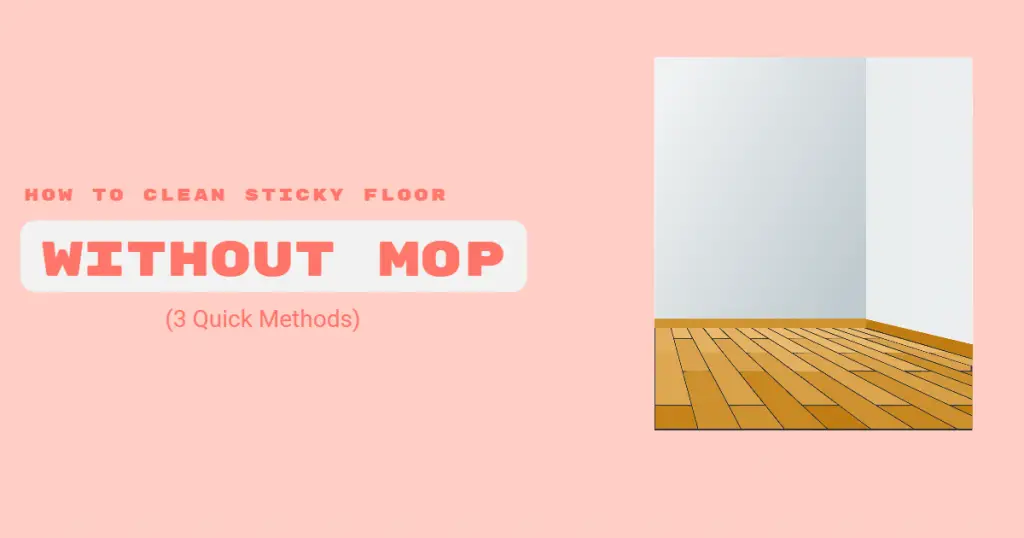
Using a suitable cloth without a mop
It can happen in a lot of ways but you can end up without a mop.
Your previous one can break or get misplaced or lose its effectiveness etcetera.
There are a lot of things that can happen that can leave you without a usable mop.
In the event of that happening, you should be able to know how to clean your floors without a mop.
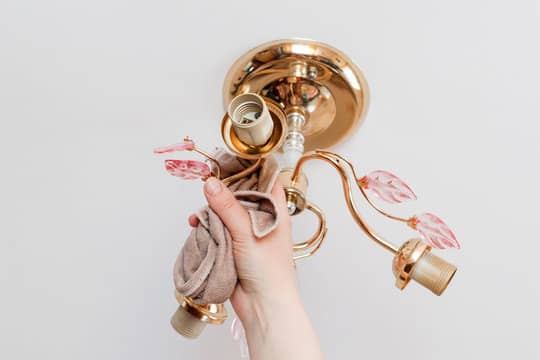
The best way to do this is to use a cloth of a suitable size.
You can drench it in water or detergent to help speed along the process of cleaning.
Afterward, you can clean it similarly to cleanse it of germs and harmful substances.
Many people who use this type of method use an old pillowcase or torn piece of an old bedsheet.
But if you want to avoid spending any money on a new mop or an additional cloth, the best thing to do is to use a towel.
If you have a towel that hasn’t seen much use in a while, you can use it for cleaning floors.
The fibers and strands on the towel make it ideal for cleaning as it can scrub well.
Using towels has proven to be effective and efficient.
In most homes, the towels that have thinned out and are no longer useful are turned into cleaning cloths.
They are cleaned regularly and provide a result that is quite close to mops.
If you use them with detergents, they can give a clean outcome with pleasant fragrances.
Except for the ease of use, there is not much difference in the result.
You can use towels and old fabric-related items for cleaning without worrying about missing out on any ease and convenience provided by mops.
Scrubbing manually with your hands
Regardless of which cloth you use for cleaning, the best way to do so is to scrub manually using your hands.
Some people just use their feet to scrub and that can result in a half-hearted outcome where some sort of grime or dirt remains.
Some people act squeamish when it comes to scrubbing manually and it is somewhat understandable.
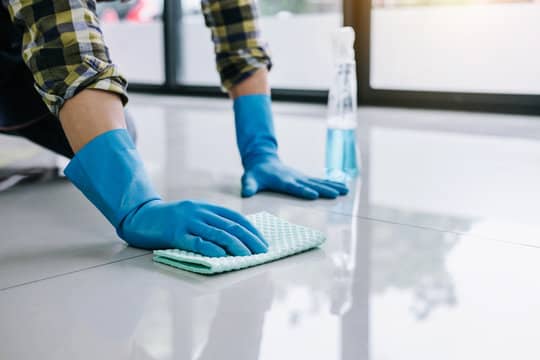
You must always clean your cloth before using them. And several guidelines must be followed for a good cleaning.
One of the most important aspects is the way you wash it and the water you use to wash it.
This issue is not addressed as much but if you wash your cloth using hard water, it can result in some disfiguring outcomes.
If you wash your mops with hard water, which is the normal tap water in most countries, the cloth can leave marks and trails.
This is due to the adhesive property of water. It can look very ugly and off-putting.
Therefore, if you want a clean floor, you should always wash your mops with soft water.
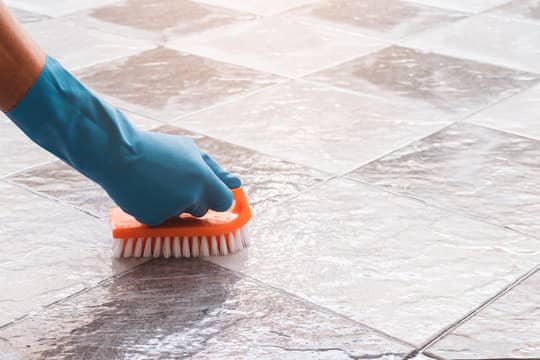
Another tip to help you clean better manually is to always carry a bucket with you.
You can put either detergent or warm water in it depending on your need.
You can drench and squeeze out your cloth at intervals. Doing this will ensure that you don’t cause any smell or repeated stains on your floors.
When you scrub with your hands, you can fixate on a persistent stain better. You can focus on the right spots and can get more cleaning done in less time.
For some people, using a cloth manually is easier and more efficient than using a mop. Although it requires more effort, it has its pros.
Using makeshift equipment
Another option that can replace mops is the use of makeshift equipment.
In most cases, this involves pegging a cloth at the end of a broom or a floor wiper.
This is quite an efficient way that can substitute actual mops.
A majority of homes usually prefer these over mops as the cloth is easily detachable and can be washed efficiently.
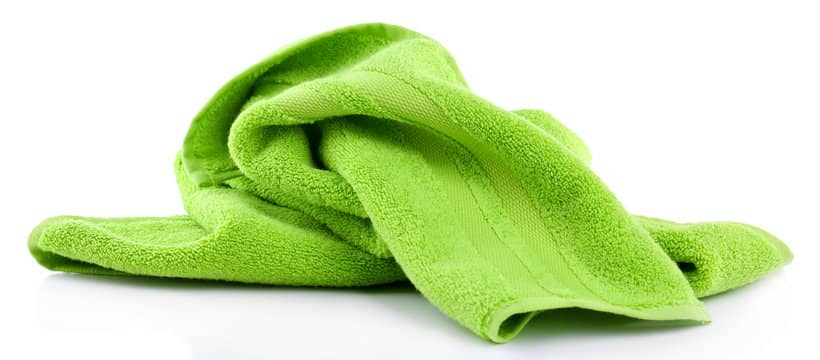
To do this you first cut a hole in the towel.
Then you proceed to put the pole of the broom or whatever it is that you are using, into that perforation.
The towel then comes to rest at the end of the pole, making a peculiar semblance of a mop.
If you want to clean the towel afterward, you can just take it off the top and do so easily.
Another useful feature of this sort of makeshift tool is that you can use it without getting your hands messy or germ-ridden.
Tips for cleaning floors without a mop
There are a few things and items you can use if you don’t have a mop and you want to clean your floors.
Additionally, there are some guidelines you can follow to get optimal results.
These include the way you use your tools, the way you wash them afterward, and the way you store them.
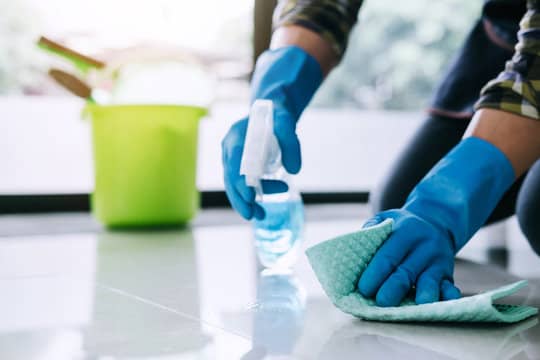
So, when it comes to using your replacement, you must use it in a way that doesn’t damage its structure or cleaning ability.
That means you have to abstain from rough handling and careless measures. Excessive washing for no reason at all is also harmful.
If you don’t wash them after cleaning, it can also damage the cloth.
You should always wash your respective cloth after using them. You should dry them before storing them.
One of the best ways to dry them is to put them in the sun but you can also tumble dry them.
Cloths have a higher tolerance than mops and are tougher.
Emphasize the use of non-toxic and eco-friendly Cleaning Solutions
The emphasis is placed on the utilization of non-toxic and environmentally friendly cleaning solutions for effectively addressing sticky floors without the need for a mop.
One alternative method involves using a microfiber cloth soaked in a cleaning solution.
To prepare the solution, mix a small amount of dish soap with warm water in a bucket.
Dip the cloth into the solution and wring it out to remove excess water. Gently scrub the sticky areas on hardwood or tile floors using circular motions.
Rinse the cloth regularly in clean water to prevent spreading dirty water around. For stubborn stains, add vinegar or baking soda to enhance the cleaning power of the solution.
Afterward, use a vacuum cleaner to remove any remaining debris or residue from the floor surface.
This approach offers an effective way to clean sticky floors while minimizing environmental impact by avoiding harmful chemicals and excessive water usage typically associated with mopping.
Homemade Cleaning Solutions
This discussion focuses on homemade cleaning solutions that can be used as alternatives to toxic and eco-unfriendly cleaning products.
One option is a vinegar and water solution, which can effectively clean sticky floors without the need for a mop.
This solution combines the natural cleaning properties of vinegar with water to create an effective and non-toxic cleaner.
Another option is a baking soda and water paste, which can be used to remove stubborn stains or dirt from floors.
This paste works by creating a gentle abrasive that helps lift grime and residue without causing damage.
Both of these homemade cleaning solutions are simple to make, affordable, and environmentally friendly alternatives to traditional cleaning products.
Option 1: Vinegar and Water Solution
In cleaning a sticky floor without using a mop, one option is to create a vinegar and water solution.
This involves mixing vinegar and water in a bucket to create a cleaning agent that effectively removes stickiness from the floor surface.
It is recommended to use a vinegar-to-water ratio of 1:1 or 2:1, depending on the severity of the stickiness.
Mixing vinegar and water in a bucket
Mixing vinegar and water in a bucket is an effective technique for removing stickiness from the floor.
To clean a sticky floor without a mop, one can create a solution by combining vinegar and water in a bucket.
Vinegar acts as a natural cleaner, while water helps to dilute the vinegar and provide moisture for cleaning.
By using this method, one can effectively clean their floor without the need for specialized tools or equipment.
Recommended vinegar-to-water ratio
To achieve optimal results, it is recommended to maintain the appropriate vinegar-to-water ratio when creating a cleaning solution for removing stickiness from surfaces.
For wood floors or laminate floors, mix 1 cup of warm water with 1/4 cup of white vinegar.
If using hot water, reduce the vinegar to 1 tablespoon.
Clean water should be used for steam cleaners and dust mops.
Alternatively, a floor spray mop cleaner starter kit can be used with a few drops of dish soap.
This will ensure effective cleaning and reduce floor cleaning time.
Option 2: Baking Soda and Water Paste
Baking soda and water paste is a popular and effective solution for cleaning sticky floors.
To create the paste, mix equal parts baking soda and water in a bowl until it forms a thick consistency.
Once the paste is ready, apply it directly to the sticky areas on the floor using a sponge or cloth, making sure to cover the entire affected area.
Creating a paste with baking soda and water
The process involves combining baking soda and water to create a paste for cleaning the sticky floor.
To make the paste, mix equal parts of baking soda and water in a bowl until it forms a thick consistency.
Once the paste is ready, apply it to the sticky areas of the floor using a sponge or cloth.
Gently scrub the surface with the paste, focusing on removing any dirt or grime.
Rinse the area with water and dry thoroughly.
This homemade cleaner provides an effective solution for cleaning sticky floors without using a mop or harsh chemicals like vinegar.
How to apply the paste to the sticky areas
Applying the paste to the areas affected by stickiness involves using a sponge or cloth to gently scrub the surface with the mixture.
To effectively clean sticky floors without a mop, follow these steps:
- Prepare the baking soda paste by mixing equal parts of baking soda and water.
- Dip a sponge or cloth into the mixture, ensuring it is saturated but not dripping.
- Apply the paste onto the sticky areas, focusing on one small section at a time.
- Gently scrub the surface in circular motions until the stickiness is removed.
By following these instructions, you can successfully clean your floor without relying on traditional mop water and achieve a clean and dry result.
Cleaning Method
When cleaning a sticky floor without a mop, it is important to follow a specific cleaning method.
First, dampen a clean microfiber cloth or rag with the chosen cleaning solution.
Next, focus on small sections of the floor at a time and wipe the sticky areas in a circular motion.
For tougher sticky spots, apply gentle pressure while wiping.
Finally, repeat this process for the entire sticky floor surface until it is thoroughly cleaned.
Dampen a clean microfiber cloth or rag with the chosen cleaning solution
To effectively address the issue of cleaning a sticky floor without using a mop, one can start by dampening a clean microfiber cloth or rag with the chosen cleaning solution.
This method offers several advantages over traditional mopping techniques.
The use of a damp microfiber mop or rag ensures that the cleaning solution is applied evenly across the floor surface, allowing for effective removal of stickiness and dirt.
Microfiber is known for its excellent absorbency and ability to trap dust and debris, making it an ideal tool for cleaning floors.
Additionally, using a clean microfiber cloth prevents cross-contamination between different areas of the floor.
By following this method, one can achieve a thoroughly cleaned and non-sticky floor without relying on a traditional mop.
Focus on small sections of the floor at a time
One effective approach is to divide the floor into smaller sections and focus on cleaning each section individually.
This method allows for a more thorough and efficient cleaning process.
To begin, ensure that you have all the necessary tools and cleaning solutions ready.
For instance, steam mops with a clean tank capacity water tank can be used for removing dirt and grime from smooth floor surfaces.
Alternatively, homemade floor cleaners can also be used along with a microfiber cloth or rag.
Start by spraying or applying a small amount of cleaning solution onto the designated section of the floor.
Use a brush or mop to scrub the area gently, making sure to remove any debris from floors effectively.
Repeat this process for each section until the entire sticky floor has been cleaned properly.
Remember to avoid using excessive amounts of water when cleaning hardwood floors without water to prevent damage.
Additionally, some individuals may prefer adding a drop or squirt of dish soap in their cleaning solution for extra efficacy in tackling sticky residues on their floors.
Overall, dividing the floor into smaller sections helps ensure a systematic approach that results in cleaner and more presentable floors.
Wipe the sticky areas in a circular motion
To effectively clean sticky floors without a mop, it is important to focus on small sections at a time and employ the proper cleaning techniques.
In order to tackle stubborn stickiness, wiping the affected areas in a circular motion can be particularly effective.
However, before engaging in this process, it is crucial to remove any dry debris from the floor.
This can be done by using a rubber floor mat or a dry microfiber cloth.
Additionally, utilizing a soft brush attachment on floor cleaning machines or employing Reichert’s SpritzandDry mop technique can help eliminate hairs from floors and other hard-to-reach areas.
To ensure thorough cleaning, finishing off with a dry microfiber dust cloth or beater bar attachment will provide optimal results.
By following these steps and implementing a bucketless mopping system, sticky floors can be cleaned efficiently and effectively without the use of traditional mops.
Apply gentle pressure for tougher sticky spots
Applying gentle pressure to the affected areas can effectively address tougher sticky spots.
When dealing with sticky floors, it is important to consider the type of floor and the proper cleaning tools to use.
For example, a pet hair remover brush or a vacuum attachment can help remove any loose debris from the surface before cleaning.
In cases where the stickiness persists, professional carpet cleaning services may be necessary.
To clean sticky spots manually, using a washable mop head with compatible microfiber pads is recommended.
This allows for efficient removal of dirt and grime without leaving residue behind.
Additionally, mixing small amounts of water with soap can aid in dissolving stubborn substances on the floor’s surface.
Afterward, using a dry microfiber cloth to wipe away any remaining moisture ensures a clean and dry finish.
Repeat the process for the entire sticky floor surface
To effectively clean a sticky floor without a mop, it is important to apply gentle pressure for tougher sticky spots.
Once the stubborn areas have been addressed, it is necessary to repeat the cleaning process for the entire sticky floor surface.
To accomplish this task efficiently, several tools and techniques can be employed:
- Utilize a microfiber mop with a brush attachment or handheld brush for dry mopping.
- For wet mopping, attach a flat head or swivel head to the mop and dampen it with water.
- Opt for bucketless mopping by spraying water directly onto the floor and then using the mop to clean.
- Ensure thorough cleaning by overlapping your strokes and moving in straight lines.
By adhering to these steps and using appropriate tools, one can achieve optimal results when cleaning a sticky floor without resorting to traditional mops.
This method helps prevent water damage while effectively removing stickiness.
Removing Stubborn Stains
In this discussion, we will focus on the topic of removing stubborn stains from floors.
The first step in this process is to identify the specific stains and sticky residues that need to be addressed.
Once these stains have been identified, it is important to choose the appropriate solution for each stain type.
Finally, step-by-step instructions will be provided for effectively removing each stubborn stain, ensuring a clean and spotless floor surface.
Identify stubborn stains and sticky residues
Stubborn stains and sticky residues can be identified by their visual appearance and texture.
To effectively clean these types of messes without a mop, it is important to first determine the specific stain or residue present on the floor.
Here is a table that outlines common stubborn stains and sticky residues that may be encountered:
| Stain/Residue | Description | Cleaning Method |
|---|---|---|
| Bleach on tile grout | White or discolored patches on grout lines | Create a solution with water and bleach, scrub affected areas with a tangle-free brush roll |
| Reicherts Spritzanddry mop technique residue | Sticky film left behind from cleaning product build-up | Dampen a microfiber dusting cloth with water, wipe the residue until it is removed |
| Bacteria with steam mop pads | Lingering odor or visible stains caused by bacteria growth | Fill an ounce spray bottle with water and vinegar solution, spray affected areas, then wipe clean |
By properly identifying stubborn stains and sticky residues, you can choose the most suitable cleaning method to restore your floor’s cleanliness.
Address specific stains with appropriate solutions
This discussion will focus on addressing specific stains on a sticky floor without using a mop.
Firstly, grease or oil stains can be effectively removed by applying an absorbent material like baking soda or cornstarch to the affected area, allowing it to sit for several minutes, and then wiping it away with a cloth or paper towel.
Secondly, adhesive residue can be tackled by using a solvent such as rubbing alcohol or acetone.
These solvents can dissolve the sticky substance and make it easier to remove using a scraper or cloth.
Lastly, gum or candy stuck to the floor can be loosened by applying ice to harden the substance. Afterward, gently scrape it off with a plastic scraper or credit card.
Overall, these methods provide effective solutions for dealing with different types of stains on a sticky floor.
Grease or oil stains
To effectively remove grease or oil stains from a sticky floor, the application of a degreaser solution is recommended.
Grease and oil stains are commonly found in kitchen floors due to cooking activities.
However, they can also be present in bathroom floors, especially if personal care products containing oils are used.
When selecting a degreaser, it is important to consider the floor material or type.
To clean these stains, use a soft-bristled broom or attach a cloth to the end of a broom handle for better results.
Adhesive residue
Adhesive residue can be effectively removed from the floor by using a solution specifically designed to dissolve and loosen the sticky substance.
To tackle this problem, consider the following options:
- Use a commercial adhesive remover recommended by the floor manufacturer.
- For cork floors, avoid harsh chemicals and opt for warm water mixed with mild detergent.
- Stone floors require specialized stone cleaners to prevent damage.
- Hard-to-clean grout lines may benefit from a mixture of baking soda and water.
These techniques will help keep your house clean, but additional options such as hiring professional cleaners or using steam cleaners are also worth considering.
Gum or candy stuck to the floor
Gum or candy stuck to the floor can be effectively removed by using a solution specifically designed to dissolve and loosen the sticky substances.
One effective solution is a mixture of one cup of vinegar and warm water.
The acidic nature of vinegar helps break down the gum or candy, making it easier to remove.
It is important to note that this method may not be suitable for all surfaces, such as carpet fibers, as vinegar can potentially damage them.
Provide step-by-step instructions for each stain removal
When it comes to removing stains from a sticky floor, following step-by-step instructions is crucial for effective stain removal.
For gum or candy stuck to the floor, the first step is to harden the sticky substance.
This can be done by placing ice cubes in a plastic bag and applying it directly onto the gum or candy until it becomes firm.
Once hardened, gently scrape off as much of the substance as possible using a plastic scraper or credit card.
Next, mix warm water with a mild detergent and apply it to the remaining residue.
Allow it to sit for a few minutes before scrubbing with a soft bristle brush or cloth.
Rinse with clean water and dry thoroughly.
Repeat these steps if necessary until all traces of gum or candy are removed from the sticky floor surface.
Drying and Final Touches
When it comes to drying and final touches after cleaning a sticky floor without a mop, there are a few key points to consider.
First, you can choose to let the floor air dry naturally or use a clean, dry cloth to gently pat it dry.
This will help remove any excess moisture and prevent streaks or water marks from forming.
Secondly, it is important to inspect the cleaned floor for any missed spots or residues that may still be present.
By doing so, you can address these areas promptly and ensure the entire floor is thoroughly cleaned.
Lastly, if there are any remaining sticky areas on the floor, you can reapply the cleaning solution specifically targeting those spots.
This will help eliminate any stubborn stains or residue that may have been left behind during the initial cleaning process.
Let the floor air dry or use a clean, dry cloth to pat it dry
To properly clean a sticky floor without using a mop, it is advisable to either let the floor air dry or employ a clean and dry cloth to gently pat it dry.
Here are some steps to follow:
- Remove any excess liquid or residue from the floor using a sponge, paper towels, or a scraper.
- Open windows or turn on fans to promote air circulation and aid in drying.
- Allow sufficient time for the floor to naturally air dry, ensuring that no moisture remains.
- Alternatively, use a clean and dry cloth to lightly press down on the surface of the floor, absorbing any remaining stickiness.
By allowing the floor to air dry or carefully patting it with a cloth, you can effectively remove stickiness without the need for a mop.
Remember to work systematically across the entire area until all stickiness has been eliminated.
Inspect the cleaned floor for any missed spots or residues
After allowing the floor to air dry or using a clean, dry cloth to pat it dry, it is essential to inspect the cleaned floor for any missed spots or residues.
This step ensures that the stickiness has been completely eliminated and that the floor is safe and hygienic.
Inspecting the floor involves carefully examining its surface, particularly in areas that may have been overlooked during the cleaning process.
It is important to pay close attention to corners, edges, and hard-to-reach places where sticky residue might accumulate.
A thorough inspection allows for any remaining stickiness to be identified and promptly addressed.
By diligently inspecting the cleaned floor, one can ensure a pristine result and maintain a clean environment free from unwanted stickiness.
Reapply the cleaning solution for any remaining sticky areas
It may be necessary to reapply the cleaning solution in areas where stickiness remains present.
This step ensures that all sticky residues are effectively removed from the floor surface.
To achieve optimal results, follow these steps:
- Identify the specific areas that still exhibit stickiness after the initial cleaning.
- Prepare a fresh batch of the cleaning solution according to the manufacturer’s instructions.
- Apply a small amount of the cleaning solution directly onto a clean cloth or sponge.
- Gently scrub the remaining sticky areas using circular motions until they become clean and free from any residue.
By reapplying the cleaning solution, you are able to target and eliminate any lingering stickiness on your floor without relying solely on a mop.
This method allows for thorough cleaning and ensures that your floors are left completely residue-free and non-sticky.
Preventative Measures
This discussion will focus on preventative measures to avoid sticky floors in the future.
Regular cleaning routines and maintenance are essential to prevent build-up of dirt, grime, and spills that can lead to stickiness.
It is important to establish a cleaning schedule and adhere to it consistently, ensuring that all areas of the floor are thoroughly cleaned and dried.
Additionally, implementing preventive measures such as using doormats at entrances, enforcing a no-shoes policy indoors, and promptly addressing spills can help maintain clean and non-sticky floors.
Offer tips on how to prevent sticky floors in the future
To prevent the occurrence of sticky floors, implementing regular cleaning routines and using appropriate floor cleaning products can be effective measures.
Regular sweeping or vacuuming helps to remove dirt and debris that can stick to the floor surface and cause stickiness.
Additionally, mopping with a mild detergent specifically formulated for the type of flooring material can help eliminate any remaining residue.
It is important to avoid using excessive water during the cleaning process as it may seep into cracks or crevices and contribute to stickiness.
Furthermore, placing doormats at entryways can help trap dirt and prevent it from being tracked onto the floor.
Lastly, promptly addressing spills or stains by blotting them up immediately can prevent them from drying and becoming sticky.
By following these preventative measures, one can maintain clean and non-sticky floors.
| Preventative Measures | Benefits |
|---|---|
| Regular cleaning routines | Removes dirt and debris |
| Appropriate floor cleaning products | Eliminates residue |
| Placing doormats at entryways | Traps dirt |
| Promptly addressing spills or stains | Prevents stickiness |
Table 1: Preventative measures to prevent sticky floors
Encourage regular cleaning routines and maintenance
Regular cleaning routines and maintenance are essential for maintaining the cleanliness and condition of the floor surface.
By establishing a consistent cleaning schedule, you can prevent sticky floors from becoming a recurring issue.
It is recommended to sweep or vacuum the floor regularly to remove loose dirt, dust, and debris.
This will help prevent them from accumulating and creating a sticky residue on the floor surface.
Additionally, mopping the floor with a suitable cleaner specifically designed for your flooring material can effectively remove any remaining stickiness.
It is important to follow the manufacturer’s instructions for both sweeping/vacuuming and mopping to ensure proper care of your floors.
Regular maintenance, such as repairing or replacing damaged tiles or planks promptly, will also contribute to preventing sticky floors in the future.
Frequently Asked Questions
Can I use regular cleaning solutions instead of non-toxic and eco-friendly ones?
Using regular cleaning solutions instead of non-toxic and eco-friendly ones may not yield the desired results for cleaning sticky floors.
Non-toxic and eco-friendly solutions are specifically formulated to effectively remove sticky residues without causing harm to the environment or individuals.
Are homemade cleaning solutions as effective as store-bought ones?
Homemade cleaning solutions can be as effective as store-bought ones when it comes to cleaning sticky floors.
However, the effectiveness may vary depending on the specific ingredients and their concentrations used in the homemade solution.
Can I use any cleaning method to clean my sticky floor?
Yes, any cleaning method can be used to clean a sticky floor.
However, it is important to consider the type of flooring and choose appropriate cleaning solutions and tools to ensure effective results without causing damage.
How can I remove stubborn stains from my sticky floor?
To remove stubborn stains from a sticky floor, first identify the type of stain and choose an appropriate cleaning method.
Treat the stain using a suitable cleaning solution or product, following the instructions carefully.
Scrub gently with a brush or cloth, rinse thoroughly, and dry the floor completely.
Are there any preventative measures I can take to avoid my floor from getting sticky again?
To prevent your floor from becoming sticky again, it is important to establish a regular cleaning routine using appropriate cleaning products.
Additionally, placing doormats at entrances and enforcing a “no shoes indoors” policy can help minimize the accumulation of dirt and grime.
Conclusion
In order to clean a sticky floor without using a mop, it is important to focus on using non-toxic and eco-friendly cleaning solutions.
Homemade cleaning solutions can be easily made using ingredients such as vinegar, baking soda, and lemon juice.
The cleaning method involves scrubbing the floor with the cleaning solution using a brush or cloth.
Stubborn stains can be removed by repeating the process or using specialized stain removers.
After cleaning, it is necessary to dry the floor thoroughly and add final touches such as polishing or waxing.
To prevent sticky floors in the future, practicing preventative measures like regular sweeping and mopping can be helpful.

